March 30, 2016
As the demand for bandwidth in enterprise applications such as data centers continues to boom, new transmission media must be developed continually to meet end user requirements. With next-generation 40 and 100 Gigabit Ethernet speeds on the horizon, the industry is developing a new type of multimode fiber called OM4. What is it? Why is it able to meet the high data rate requirements? Here is what you need to know about OM4 multimode fibers.
Two standards define the use of OM4 fiber in high-speed networks: TIA document TIA-492AAAD, which contains the OM4 fiber performance specifications; and the IEC 60793-2-10 international standard, which provides equivalent OM4 specifications under fiber type A1a.3. OM4 multi-mode fiber has a core of 50 microns, but the fiber is optimized for laser based equipment that uses fewer modes of light. It is designed to enhance the system cost benefits enabled by 850 nm VCSELs (vertical cavity surface emitting lasers) for existing 1Gbps and 10Gbps applications as well as future 40Gbps and 100Gbps systems. OM4 fiber will support Ethernet, Fibre Channel, and OIF applications, allowing extended reach upwards of 550 meters at 10Gbps for ultra long building backbones and medium length campus backbones. With an Effective Modal Bandwidth (EMB, also known as laser bandwidth) of 4700 MHz-km(more than double the IEEE requirement for 10Gbps 300 meter support), OM4 fiber is also especially well suited for shorter reach data center and high performance computing applications. It is important to note that OM4 glass is not necessarily designed to be a replacement for OM3. Despite the relatively long-standing availability of OM4, there are no plans to obsolete OM3 fiber optic cabling.
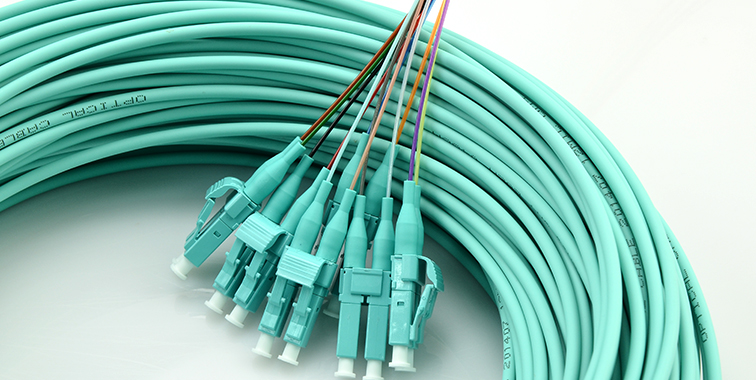
OM4 provides an opportunity to future-proof cabling infrastructure. OM4 is completely backwards-compatible with existing OM3 systems. As a result, these two grades of glass are interchangeable within the transmission distance limitations. The additional bandwidth and lower attenuation of OM4 provide additional insertion loss margin. As a result, users of OM4 gain additional safety margin to help compensate for less-than-ideal cabling installations as well as provide margin for degradation due to moves, adds, and changes over the life of the installation.
OM4 is the latest high modal bandwidth high performance 50/125 Graded Index Multimode (GIMM) cabled fibre specification. OM4 fiber enables extended range performance over high bit rate links such as 8 Gigabit Fiber Channel and 10 Gigabit Ethernet compared to existing fibre types. OM4 fiber patch cable can be regarded as improvement on the existed OM3 standards. Its assemblies are ready to meet the requirement for future 40G and 100G fiber optic networks, there are simplex and duplex OM4 multimode fiber patch cord types. OM4 multimode fiber patch cable are terminated with different fiber optic connectors, like LC, SC, ST, FC, MTRJ, MU, and E2000. These cables can be simplex or duplex and customized in optional lengths.
The demand for the development of network transmission requires that optical fiber can support future 40Gbit/s and 100Gbit/s transmission. OM4 fiber provides next generation multimode fiber performance for today and tomorrow's high speed applications. With its significantly higher bandwidth, network designers and operators can be assured that fiber patch cord will continue to provide the most cost effective solutions for short reach applications in data centers and LANs. Laser-optimized multi-mode fiber OM4 takes advantage of 850 nm VCSEL laser technology to reduce the overall cost, provide you with higher bandwidth choices.
Posted by: jowang at
02:53 AM
| No Comments
| Add Comment
Post contains 580 words, total size 5 kb.
March 28, 2016
Fiber jumpers continue to provide a cost-effective cabling solution for data centers, local area networks (LANs), and other enterprise applications. Singlemode fiber optic patch cords and multimode fiber optic patch cords are two options. Compared to singlemode fiber, multimode fiber has a large diameter core, which allows multiple wavelengths of light traveling in the fiber core at the same time. Multimode fiber optic patch cord comes with two core sizes: 50 micron and 62.5 micron. And this article will talk about these two core sizes of multimode fiber optic cables.
The numbers 50µm and 62.5µm refer to the diameters of the glass or plastic core, the part of the fiber that carries the light which encodes your data. The dimensions are sometimes specified as 50/125μm and 62.5/125μm, to include the diameter of the cladding, which confines the light to the core because it has a lower index of refraction. You can use both in the same types of networks, although 50µm cable is recommended for premise applications, like backbone, horizontal, and intrabuilding connections. They both can use either LED or laser light sources. The main difference between 50µm and 62.5µm cable is in bandwidth, 50µm cable features three times the bandwidth of standard 62.5µm cable, particularly at 850nm. The 850nm wavelength is becoming more important as lasers are being used more frequently as a light source. Other differences are distance and speed. 50µm cable provides longer link lengths and higher speeds in the 850nm wavelength.

OM1 fiber optic cable is the 62.5/125 multimode fiber cable. OM1 fiber has a bigger core diameter, which makes it better at concentrating the light and bend-resistance. OM1 fiber was the indoor cabling standard chosen by AT&T, ANSI and IBM. For OM1 fiber cable, the max attenuation is 3.5dB/km working at 850nm, 1.5dB/km at 1300nm. Overfilled launch of OM1 fiber optic cable at 850nm is 200MHz*km, at 1300nm is 500MHz*km. Today, OM1 fiber optic cables are still a popular indoor use multimode fiber optic cable.
50µm fiber includes OM2, OM3, OM4. OM2 fiber optic cable refer to the commonly used 50/125 traditional multimode fiber cable. OM1 and OM2 are both orange jacketed cable, and you cannot judge from the outer diameter to identify OM1 and OM2 fiber cable, because the 50/125 and 62.5/125 refer not to whole cable diameter but to the fiber inside. OM2 multimode fiber cables are used in fiber optic telecommunications and high speed transmission systems that require simultaneous, bi-directional data transfer.
OM3 cable and OM4 cable are both optimized for laser based equipment that uses fewer modes of light. As a result of this optimization, they are capable of running 10 Gigabit Ethernet at lengths up to 300m and 550m respectively. OM4 is completely backwards compatible with OM3 fiber and shares the same distinctive aqua jacket. OM4 was developed specifically for VSCEL laser transmission. OM4 multimode fiber optic cable is the highest level of multimode fiber optic cable that you can use. They can be used in networks where an overwhelming or extreme amount of data transfers will take place.
Given its superior technical characteristics for high-speed links, 50μm fiber is the clear choice for new multimode fiber links in most circumstances. OM3-grade, high-bandwidth 50/125-micron fiber cable increases the flexibility of network designs and achieves data transfer rates up to 10Gbps at the lowest available cost. 50μm multimode fiber is the medium of the future, with 62.5μm fiber being supported chiefly for legacy purposes. However, the majority of the fiber deployed in the world today is 62.5μm, so backward compatibility is an important concern. On the other hand, there are no technical drawbacks to using different fiber types in separate network links, as long as the ports at both ends of the link are compatible with the cable. In a word, installing 50μm fiber for new network links is a good investment for future growth.
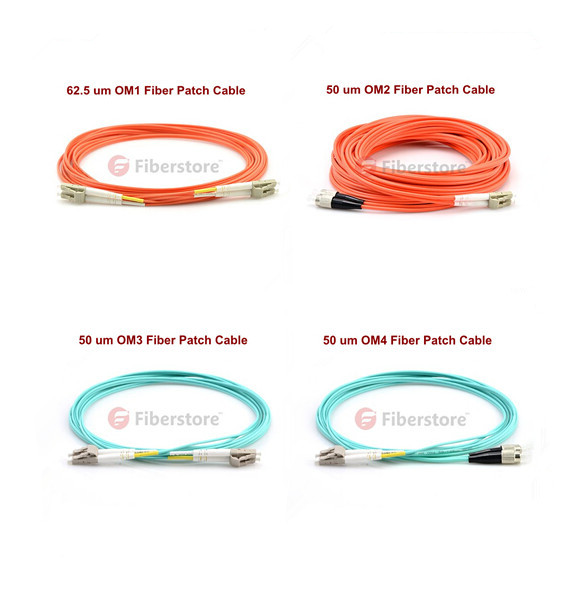
With the increasing demand for network capacity, upgrades must be planned with an eye to the future. Installing 50μm multimode fiber today brings immediate benefits of longer cable reach and improved light loss budget margins, and prepares the network for future upgrades.
Posted by: jowang at
03:38 AM
| No Comments
| Add Comment
Post contains 713 words, total size 6 kb.
March 24, 2016
These are two standards for single mode fibre optic cabling that are generally used today, OS1 and OS2. OS1 and OS2 are cabled single mode optical fibre specifications. The difference between OS1 and OS2 fiber optic cables mainly lie in the performance due to cable construction. How are OS1 and OS2 single mode fiber cables constructed? Choosing the right fiber jumper is very critical to improve the functionality of your network. Here is some information related to the differences between the OS1 and OS2 single mode fiber cables.
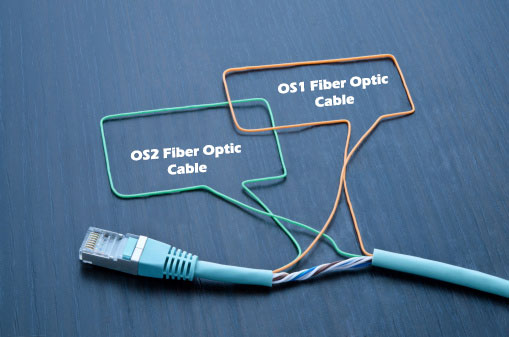
OS1 single mode fibers are compliant with ITU-T G.652A/B, and the low-water-peak fibers defined by ITU-T G.652C and G.652D also come under OS1 single mode fibers, that is to say OS1 is compliant with specifications of ITU-T G.652. OS1 cabling is tight-buffered construction, embedded in a heavy polymer jacket. The jacketed fiber is generally enclosed, with a bundle of flexible fibrous polymer strength members like aramid in a lightweight plastic cover to form a simple cable.
OS2 single mode fibers are only compliant with ITU-T G.652C/D standards, which means that OS2 fibers are very clearly the low-water-peak fibers only. OS1 was first introduced in the year 2002 and OS2 in the year 2006. OS2 cabling is loose-tube design. Cable with this construction is appropriate for outdoor cases. For use in more strenuous environments, a much more robust cable construction is required. In loose-tube construction, the fiber is laid helically into semi-rigid tubes, allowing the cable to stretch without stretching the fiber itself. This protects the fiber from tension during laying and due to temperature changes.
For their different cable constructions, OS1 and OS2 fiber cables have different application areas. OS1 is for indoor use, such as campusand data centre. Cabling is is tight buffered (manufactured into solid medium). Indoor fiber is more tolerant of bending. The fiber is more plastic and able to bend plus the buffered cable reduces the risk of catastrophic damage. OS2 is for outdoor or loose tube use, like street, underground/burial, etc. Outdoor fibers are bend sensitive and thus more likely to break during install unless care is taken.
Besides, they also have different degrees of attenuation. OS1 indoor fiber has greater loss per kilometer than OS2. In general, the maximum attenuation for OS1 is 1.0 db/km and 0.4db/km for OS2. As a result, the maximum transmission distance of OS1 single mode fiber is 2 km but the maximum transmission distance of OS2 single mode fiber can reach 5 km and up to 10 km. Though the maximum transmission distance of OS2 single mode fiber is much longer than that of OS1, OS1 is much cheaper than OS2 for the cheaper materials.
But both OS1 and OS2 cable types allow a distance of one to 10 gigabit Ethernet. And another point which needs to be paid attention to is that OS2 single mode optical fiber cables can not be connected with OS1 single mode optical fiber cables because it may lead to unpredictable signal performance. Fiberstore supplies both OS1 and OS2 single mode patch cables, and all other kinds of fiber patch cords with differernt connector options, such as SC single mode patch cable, LC multi-mode patch cable, MPO cable, etc. We provide fiber-based patch cables with high quality.
Posted by: jowang at
02:20 AM
| No Comments
| Add Comment
Post contains 557 words, total size 5 kb.
March 23, 2016
Fiber optic patch cable is a simple fiber optic elements, consisting of a short length of optical fiber cable with a connector at each end. According to the optical connectors terminated on both ends, fiber jumpers can be divided into many different types. FC, SC, ST, LC, and MT-RJ are several commonly used connector types. Fiber patch cords with these five kinds of connectors will be briefly introduced below.
 FC Fiber Optic Patch Cord
FC Fiber Optic Patch CordFC connector is the choice for singlemode fibers and mainly used in SM fiber optic components and in high speed fiber optic communication links. This high precision, ceramic ferrule connector is equipped with an anti rotation key, reducing fiber endface damage and rotational alignment sensitivity of the fiber. The key is also used for repeatable alignment of fibers in the optimal, minimal loss position. FC fiber optic patch cord come with a zirconia ceramic ferrule with pre-polished PC profile and convex spherical end, and both singlemode and multimode versions of FC fiber optic patch cable are available.
 ST Fiber Optic Patch Cord
ST Fiber Optic Patch CordST connector is used extensively in field and indoor fiber optic LAN applications. Its high precision, ceramic ferrule allows its use with both multimode and singlemode fibers. ST fiber cable connector has a bayonet-style housing and a long spring-loaded ferrule hold the fiber, preventing over tightening and damaging of the fiber end. Horizontally mounted simplex and duplex adapters are available with metal or plastic housing, with a choice of phosphor bronze or zirconia split sleeve. ST fiber patch cord is one of the older generations of connector, but is still widely used for multimode networks, including LANs for buildings and campuses.
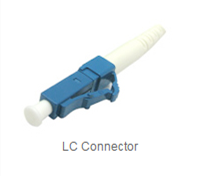 LC Fiber Optic Patch Cord
LC Fiber Optic Patch CordLC connector utilizes the traditional components of a SC duplex connector, having independent ceramic ferrules and housings with the overall size scaled down by one half. The LC family of connectors indcludes a stand-alone simplex design, a "behind the wall" (BTW) connector available in both simplex and duplex configurations. LC fiber optic patch cord is a push and latch structure. It is widely used for densely installation with high performance and is highly favored for singlemode applications.
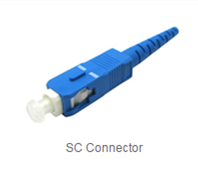 SC Fiber Optic Patch Cord
SC Fiber Optic Patch CordSC connector is becoming increasingly popular in singlemode fiber optic telecom and analog CATV, field deployed links. The high precision, ceramic ferrule construction is optimal for aligning singlemode optical fibers. The connector's outer square profile combined with its push-pull coupling mechanism, allows for greater connector packaging density in instruments and patch panels. The keyed outer body prevents rotational sensitivity and fiber endface damage. Multimode versions of SC connector are also available. SC fiber patch cord is one of the most commonly used fiber optic cable in fiber optic networks, convenient to use and cost-saving.
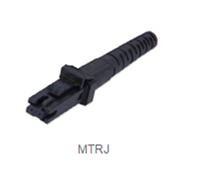 MT-RJ Fiber Optic Patch Cord
MT-RJ Fiber Optic Patch CordMT-RJ connector uses a form factor and latch similar to the 8P8C (RJ45) connectors. Two separate fibers are included in one unified connector. It is easier to terminate and install than ST or SC connectors. The smaller size allows twice the port density on a face plate than ST or SC connectors. There are two variations: pinned and no-pin. The pinned variety, which has two small stainless steel guide pins on the face of the connector, is used in patch panels to mate with the no-pin connectors on MT-RJ patch cords. MT-RJ fiber connectors utilize precision molded MT ferrules pioneered by NTT, together with precision metal guide pins and precise housing dimensions to ensure fiber alignment when mating. MT-RJ fiber patch cable is reliable and simple to terminate.
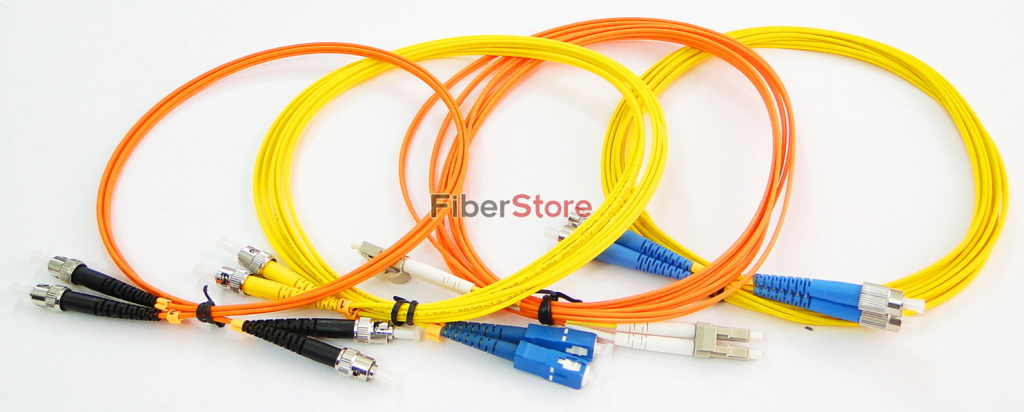
Fiber optic patch cables are used to connect various componets and instruments in a fiber optic system. Connectors on both ends can determine the overall performance of the system to some degree. Other than choosing singlemode or multimode, simplex or duplex fiber optic patch cables, you also need to make the right choice of which cnnector type you need.
Posted by: jowang at
02:22 AM
| No Comments
| Add Comment
Post contains 659 words, total size 7 kb.
March 18, 2016
We know that fiber optic patch cables play a very important role in the connection between devices and equipment. When talking about fiber optic patch cables, we usually divide them into multimode fiber optic patch cables and singlemode fiber optic patch cables according to the modes of the cable. What is multimode fiber optic patch cable? How many types of multimode patch cables are there? And what is the difference between multimode and singlemode patch cables? What are the applications of multimode patch cables? This text will solve those questions one by one.
Multi-mode fiber patch cables are described by the diameters of their core and cladding. There are two different core sizes of multi-mode fiber patch cords: 50 microns and 62.5 microns. Both 62.5 microns and 50 microns patch cable feature the same glass cladding diameter of 125 microns. Thus, a 62.5/125µm multi-mode fiber patch cable has a 62.5µm core and a 125µm diameter cladding; and a 50/125µm multi-mode fiber patch cable has a 50µm core and a 125µm diameter cladding. The larger core of multi-mode fiber patch cords gathers more light and allows more signals to be transmitted, as shown below. Transmission of many modes of light down a multi-mode fiber patch cable simultaneously causes signals to weaken over time and therefore travel short distance.
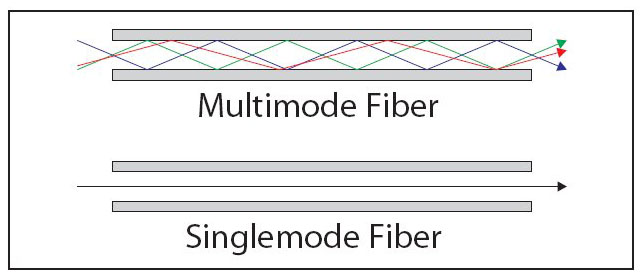
Multimode fiber optic cables can be divided into OM1, OM2, OM3, and OM4 based on the types of multimode fiber. The letters "OM" stands for optical multimode. OM1 and OM2 belong to traditional multimode fiber patch cable, while OM3 and OM4 belong to the new generation fiber patch cable which provides sufficient bandwidth to support 10 Gigabit Ethernet up to 300 meters. The connector types include LC, FC, SC, ST, MU, E2000, MPO and so on. Different type of connector is available to different equipment and fiber optic cable.
By the materials of optic fiber cable jackets, multimode fiber patch cord can be divided into four different types, PVC, LSZH, plenum, and armored multimode patch cable. PVC is non-flame retardant, while the LSZH is flame retardant and low smoke zero halogen. Plenum is compartment or chamber to which one or more air ducts are connected and forms part of the air distribution system. Because plenum cables are routed through air circulation spaces, which contain very few fire barriers, they need to be coated in flame-retardant, low smoke materials. Armored fiber patch cable use rugged shell with aluminum armor and kevlar inside the jacket, and it is 10 times stronger than regular fiber patch cable.
Multimode and singlemode fiber optic patch cables are different mainly because they have different sizes of cores, which carry light to transmit data. Singlemode fiber optic patch cables have a core of 8 to 10 microns. Multimode fiber patch cable allows multiple beams of light passing through, while singlemode fiber cable allows a single beam of light passing through. As modal dispersion happens in multimode fiber cable, the transmission distance is relevantly nearer than singlemode fiber cables. Therefore, multimode fiber optic patch cable is generally used in relevantly recent regions network connections, while the singlemode fiber cable is often used in broader regions.
Multi-mode fiber patch cables are used to connect high speed and legacy networks like Gigabit Ethernet, Fast Ethernet and Ethernet. OM1 and OM2 cables are commonly used in premises applications supporting Ethernet rates of 10Mbps to 1Gbps, which are not suitable though for today's higher-speed networks. OM3 and OM4 are best multimode options of today. For prevailing 10Gbps transmission speeds, OM3 is generally suitable for distance up to 300 meters, and OM4 is suitable for distance up to 550 meters.
Fiber optic patch cords are designed to interconnect or cross connect fiber networks within structured cabling systems. Typical fiber connector interfaces are SC, ST, and LC in either multimode or singlemode applications. Whether to choose a singlemode or multimode fiber patch cable, it all depends on applications that you need, transmission distance to be covered as well as the overall budget allowed.
Posted by: jowang at
04:23 AM
| No Comments
| Add Comment
Post contains 695 words, total size 6 kb.
March 17, 2016
For many years, OM1 (62.5/125µm) and conventional OM2 (50/125µm) multi-mode fiber were widely deployed in premises applications. They easily support applications ranging from Ethernet to gigabit Ethernet and their relatively large core size were ideal for use with LED transmitters. With the improvement of network speed and size, modulation rates is up to 10Gbit/s. To meet the needs of 10Gbit/s transfer rate, the ISO/IEC and the TIA jointly draft a new generation of 50μm core multimode fiber standard, which are the laser-optimized multi-mode fiber, OM3 and OM4.

OM3 multi-mode fiber also has a core of 50 microns, but the fiber is optimized for laser based equipment that uses fewer modes of light. Due to this optimization, OM3 multi-mode fiber is capable of running 10 Gigabit Ethernet at lengths up to 300 meters. LEDs have a maximum modulation rate of 622 Mbit/s because they can not be turned on/off fast enough to support higher bandwidth applications. Vertical cavity surface emitting laser (VCSEL) light sources are capable of modulation over 10Gbit/s and are used in many high speed networks. VCSELs become popular in the high-speed networks. Difference between the two light-emitting devices leads to the transformation of optical fibers to adapt to changes in light. The migration to OM3 has occurred as users upgrade to higher speed networks. OM3 optical fiber has an effective modal bandwidth (EMB) of 2000. It is designed for 10Gbit/s transmission.
OM4 optical fiber is a 50µm laser-optimized multi-mode fiber with extended bandwidth. OM4 standards are made to improve the effective modal bandwidth (EMB) and the full bandwidth of the injection (OFL) compared to OM3 optical fiber. It is used in networks where an overwhelming or extreme amount of data needs to be transferred. Like OM3 multi-mode fiber, OM4 optical fiber is also "laser-optimized" or optimized for use with 850nm VCSEL light sources. OM4 optical fiber has a lower insertion loss and an EMB of 4700. It is the preferred technology for the emerging standards that will operate at 40Gbps and even 100Gbps.
OM4 optical fiber is mainly used to support high-speed Ethernet, Fibre Channel (FC) and fiber optic interconnection (OIF). Meanwhile, it can support up to 550 meters in a 10Gbit/s system, so you can use it for building backbone and campus backbone extraordinary distance from the middle. In the data center design, within 100 meters, it can support higher speed (40Gbit/s and 100Gbit/s Ethernet, 16Gbit/s and 32Gbit/s Fibre Channel) data transmission requirements.
OM4 optical fiber was refer to the upgraded version of OM3 optical fiber. OM4 optical fiber standards are made to improve the 850nm wavelength effective modal bandwidth (EMB) and the full bandwidth of the injection (OFL) compared to OM3 optical fiber. Bandwidth standard of OM4 optical fiber is about twice of OM3 optical fiber, you can have greater redundancy construction and design with OM4 optical fiber. For example, when applied to 10Gbit/s system, you can give designers more space, allowing CP link to add more connection points, increasing the design, construction and flexible moves, adds and changes (MACs).
Now with the demand for the development of network transmission, it requires that optical fiber can support future 40Gbit/s and 100Gbit/s transmission. To meet the needs of this development, laser-optimized multi-mode fiber OM3 and OM4, taking advantage of 850 nm VCSEL laser technology to reduce the overall cost, provide you with higher bandwidth choices. Fiberstore (FS.COM) offers a variety of fiber jumpers or fiber optic patch cables, including OM3 multi-mode fiber patch cable assemblies and OM4 multi-mode fiber patch cable assemblies. You can find what you need from us.
Posted by: jowang at
02:17 AM
| No Comments
| Add Comment
Post contains 616 words, total size 5 kb.
March 14, 2016
In communication networks, many transmission lines need bidirectional transmission. This need leads to the development of Bidirectional (BiDi) transceivers, which can transmit and receive data to/from interconnected equipment through a single optical fiber. BiDi transceivers are fitted with wavelength division multiplexing (WDM) diplexers, which combine and separate data transmitted over a single fiber based on the wavelengths of the light. BiDi transceivers must be deployed in matched pairs, with their diplexers tuned to match the expected wavelength of the transmitter and receiver that they will be transmitting data from or to. In this post, a kind of BiDi transceiver, 1000BASE-BX SFP BiDi transceiver will be introduced.
1000BASE-BX is a part of the Gigabit Ethernet standard related to transmission over fiber optic cable. 1000BASE-BX SFP modules are compliant with SFP Multi-Source Agreement (MSA) specification and SFF-8472, and conform to the IEEE 802.3ah 1000BASE-BX10 standard. 1000BASE-BX SFP modules include 1000BASE-BX-U SFP module and 1000BASE-BX-D SFP module. These two SFP modules must be used in pairs to permit a bidirectional Gigabit Ethernet connection using a single strand of single mode fiber (SMF) cable. These transceivers transmit and receive signals on one fiber strand using two wavelengths in each direction. These hot pluggable optical transceivers consist of two sections: the transmitter section uses 1490nm DFB laser/1310nm Fabry-Perot laser, and the receiver section uses 1310nm/1490nm receiver accordingly. The 1000BASE-BX-D SFP operates at wavelengths of 1490nm TX/1310nm RX, and the 1000BASE-BX-U SFP operates at wavelengths of 1310nm TX/1490nm RX. These transceivers use standard simplex LC connectors for fiber cable connection and provide a long transmission distance of up to 10 km.
- Data rate up to 1.25 Gbps
- Hot-pluggable SFP footprint
- 1490 nm DFB Transmitter and 1310 nm PIN Receiver
- 1310 nm FP Transmitter and 1490 nm PIN Receiver
- Transmission distance up to 10 km
- Simplex LC connector
- Low power dissipation
- Digital diagnostic monitor interface is compliant with SFF-8472
- Compliant with SFP MSA Specification
- Compliant with IEEE 802.3z Gigabit Standard
- RoHS compliance
1000BASE-BX-D SFP supports link length of up to 10km point to point on single mode fiber (1490nm-TX/1310nm-RX wavelength) at 1Gbps bidirectional. This optic uses an LC connector. The picture below show a Cisco GLC-BX-D compatible 1000BASE-BX-D SFP 1490nm-TX/1310nm-RX transceiver. The GLC-BX-D is a small form factor pluggable module for Gigabit Ethernet 1000BASE-BX and Fiber Channel communications. The GLC-BX-D transceiver operates at 1490Tx/1310Rx wavelength. It is compatible with the IEEE 802.3ah 1000BASE-BX10-D standards. A 1000BASE-BX-D device is always connected to a 1000BASE-BX-U device with a single strand of standard SMF.
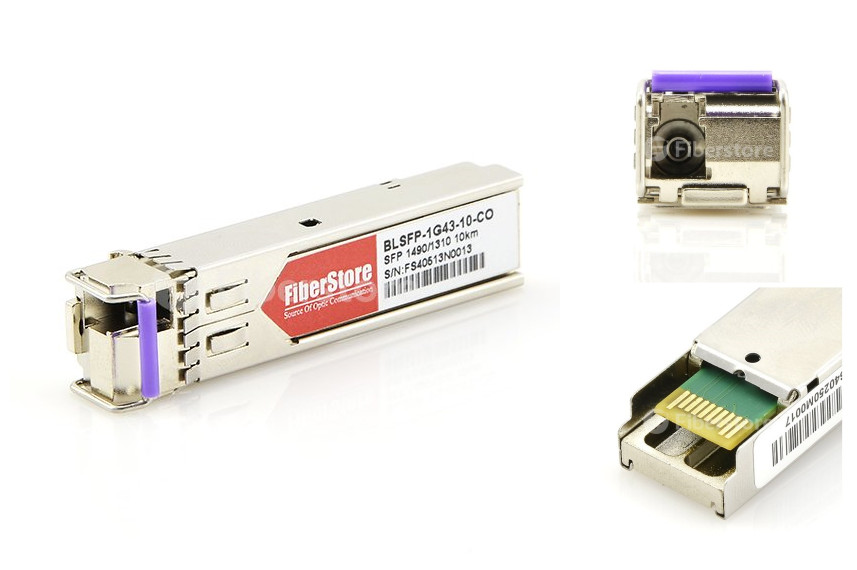
1000BASE-BX-U SFP supports link length of up to 10km point to point on single mode fiber (1310nm-TX/1490nm-RX wavelength) at 1Gbps bidirectional. This optic uses an LC connector. The communication over a single strand of fiber is achieved by separating the transmission wavelength of the two devices. 1000BASE-BX-D transmits a 1490nm channel and receives a 1310nm signal, whereas 1000BASE-BX-U transmits at a 1310nm wavelength and receives a 1490nm signal. A wavelength-division multiplexing (WDM) splitter integrated into the SFP to split the 1310nm and 1490nm light paths. The GLC-BX-D and GLC-BX-U SFPs also support digital optical monitoring (DOM) functions according to the industry-standard SFF-8472 multisource agreement (MSA). This feature gives the end user the ability to monitor real-time parameters of the SFP, such as optical output power, optical input power, temperature and transceiver supply voltage. The picture below show a Cisco GLC-BX-U compatible 1000BASE-BX-U SFP 1310nm-TX/1490nm-RX transceiver.
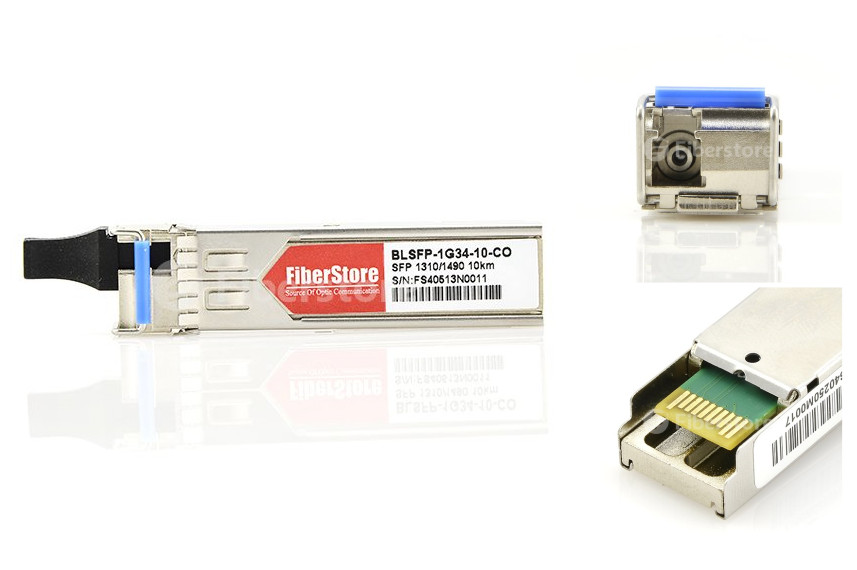
- Gigabit Ethernet
- Fiber Channel Links
- Switch to switch interface
- Switched backplane applications
- Pouter/Server Interface
- Other optical transmission systems
New organizational applications, virtualization, and data center consolidation trends are pushing your server I/O requirements to meet higher needs than before. With new BiDi optical technology, SFP BiDi transceivers make it much easier for you to upgrade your networks.
Posted by: jowang at
09:33 AM
| No Comments
| Add Comment
Post contains 631 words, total size 8 kb.
March 11, 2016
When reading parameters of an SFP transceiver, you may see words like "DOM". Do you know what's the meaning of "DOM"? And why should an SFP transceiver be with DOM? In this post, some detailed information about DOM will be given.
DOM, short for digital optical monitoring, is used to monitor some parameters of the transceiver in real-time, helping to identify the location of the fiber link failure, simplify maintenance, and improve system reliability. DOM allows you to monitor the TX (transmit) and RX (receive) power of the module, temperature, and transceiver supply voltage. You can configure your device to monitor optical transceivers in the system, either globally or by specified port. When this feature is enabled, the system monitors the temperature and signal power levels for the optical transceivers in the specified ports. Console messages and syslog messages are sent when optical operating conditions fall below or rise above the SFP manufacturer's recommended thresholds. With DOM, network administrators can check and ensure that the module is functioning correctly in an easy and convenient way. This is why most of modern optical SFP transceivers support DOM functions. The following image shows a Brocade E1MG-SX-OM compatible 1000BASE-SX SFP DOM transceiver. With DOM function, it isable to assist network designers in detecting and digitizing parameter signals on circuit board inside the SFP module.
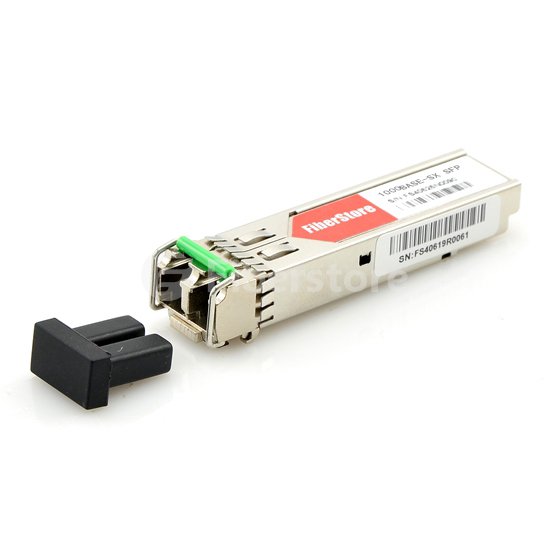
To ensure the DOM capability function well, both the device and the platform must support the feature. When the transceiver module is DOM-enabled, a minimum software version may be required to support the feature in each platform. There are some restrictions of using DOM. Ensure that your optical transceiver supports DOM; specifies the time interval for monitoring optical transceivers; in case of combo ports with SFP and RJ45 provision, when SFP is inserted in slot or port and media type is not configured to SFP, DOM is functional only if global transceiver monitoring is enabled.
With the popularity of DOM function, there are many SFP transceivers are with DOM, like 1000BASE-LX SFP DOM transceiver, 1000BASE-SX SFP DOM transceiver, 1000BASE-LX SFP DOM transceiver, 1000BASE-EX SFP DOM transceiver, and 1000BASE-ZX SFP DOM transceiver. And there are many third-party optical transceiver include the DOM functionality. What should be mentioned here is that although optical transceivers with DOM are much popular than those without DOM, some user still use the older optical transceivers in consideration of the upgrading costs.
SFP transceivers with DOM help to ensure that the business can be proactive in preventative maintenance of the network and ensure business continuity. And it would easy to explain why modern transceivers are with DOM. It is an irresistible development trend of industry and technology. Fiberstore is a professional optical transceiver manufacturer and supplier, which offers a with varity of compatible SFP transceivers with DOM functionality with a low cost. For example, Allied Telesis AT-SPSX compatible 1000BASE-SX SFP DOM transceiver costs only $6.00, and NETGEAR AGM732F compatible 1000BASE-LX SFP DOM transceiver costs only $7.00.
Posted by: jowang at
06:59 AM
| No Comments
| Add Comment
Post contains 510 words, total size 5 kb.
March 10, 2016
WDM (wavelength division multiplexing) technology, based on the concept of using multiple wavelengths of light on a single fiber, has been very popular in today's data transmission. Dense WDM (DWDM) is one type of WDM which uses the C-Band transmission window with denser channel spacing. In a 10G DWDM network application, there are multiple transceiver choices for you. Among them, this article will introduce one option for you, DWDM C-band tunable XFP module.
The tunable DWDM transceiver is a unique product which enables you to set the channel or "color" that the laser emits. This type of transceiver has been around for a number of years but it was not until 2008 that the first tuneable optics were available in the pluggable XFP form factor. Tunable transceivers are only available in DWDM form because the CWDM grid is too wide. Typically these tunable optics are for the C-Band 50GHz. Around 88 different channels can be set with intervals of 0.4nm, which is the 50GHz band. Tunable transceivers are typically used as "spare-optics", in case of emergency, because you can tune them to the right channel and reduce the amount of spare optics you need to hold in stock.
DWDM tunable XFP 10 Gbps multiprotocol optical transceiver is an integrated fiber optic transceiver that provides a high-speed serial link of signaling rates. The module complies with the 10 Gigabit small form factor pluggable (XFP) multi-source agreement (MSA), and the ITU-T G.698.1 S-D100S1-2D standard. It features a hot-pluggable XFI-compliant electrical interface. DWDM tunable XFP transceiver integrates the receive and transmit path on one module. On the transmit side, the 10 Gbps serial data stream is recovered, retimed, and passed to a modulator driver. The modulator driver biases and modulates a C-band-tunable integrated laser, enabling data transmission over single-mode fiber through an industry-standard LC connector. On the receive side, the 10 Gbps optical data stream is recovered from an APD/transimpedance amplifier, retimed, and passed to an output driver. DWDM tunable XFP transceiver is designed to support full range of C-band ITU-T wavelength data rates from 9.95Gbps to 11.3Gbps and distances up to 80km. The image below shows a Cisco ONS-XC-10G-C compatible 10G DWDM C-band tunable XFP transceiver.
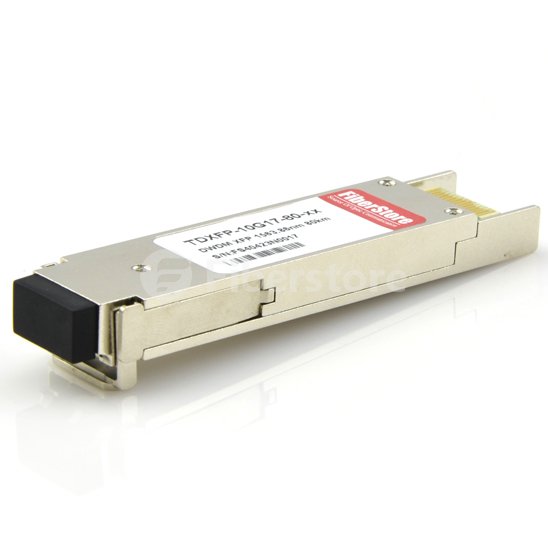
- XFI electrical interface compliant
- Hot-pluggable XFP footprint
- 80km MZM tunable TOSA
- RoHS6 compliant
- Client side and line side loopback functions
- XFP MSA compliant form factor connector
- Supports 50GHz ITU-based channel spacing (C-Band)
- With wavelength locker function, wavelength precision about 0.02nm
DWDM tunable XFP pluggable module allows enterprise companies and service providers to provide scalable and easy-to-deploy 10 Gigabit LAN, WAN, and Optical Transport Network (OTN) services in their networks. This module is a high performance and cost effective XFP transceiver module designed for 10G SDH/SONET, IEEE DWDM 10GBASE-ZR for 40 or 80 km reach (Ethernet), and DWDM 10G FC (Fibre Channel) for 40 or 80 km reach applications.
Fiberstore offers a variety of optical modules for extensive applications like telecommunication, datacommunication, and CWDM/DWDM network. Fiberstore's DWDM C-band tunable XFP transceivers can be designed to be compatible with many major brands while delivering the deployment flexibility and inventory control. And Fiberstore provides a variety of industry standard from factors including SFP+, X2, XFP, SFP, like Avago AFBR-709SMZ compatible 10GBASE-SR/SW SFP+ and Allied Telesis AT-SPSX compatible 1000BASE-SX SFP transceivers, which can make the customers satisfied with the broad choices and high performance.
Posted by: jowang at
06:46 AM
| No Comments
| Add Comment
Post contains 576 words, total size 6 kb.
March 09, 2016
The SFP transceiver modules are hot-pluggable I/O devices that plug into module sockets. The transceiver connects the electrical circuitry of the module with the optical or copper network. There are many choices of SFP modules. You may see an SFP module labeled as 10/100/1000BASE-T SFP. As we know, 1000BASE-T is a standard for Gigabit Ethernet over copper wiring. How about 10/100/1000BASE-T SFP module? What is a 10/100/1000BASE-T SFP module? In this post, a brief introduction about 10/100/1000BASE-T SFP module will be given.
The 10/100/1000BASE-T SFP small form-factor pluggable (SFP) transceiver is based on the SFP Multi Source Agreement (MSA). It is a copper SFP supporting 10/100/1000BASE-T copper Ethernet standards. It is compatible with the Gigabit Ethernet and 1000BASE-T standards as specified in IEEE 802.3z and 802.3ab. 10/100/1000BASE-T electrical SFP transceivers use an integrated RJ-45 connector with transformer and PHY IC. The link length is up to 100m over four pair Category 5 UTP cabling. With the hot pluggability, the module offers a flexible and easy way to be installed into SFP MSA compliant ports at any time without the interruption of the host equipments operating online. Besides, this 10/100/1000Mbps SFP transceiver operates at wide temperature ranges and provides high performance. It is ideal for full-duplex Gigabit Ethernet connectivity to high-end workstations and wiring closets utilizing existing copper network infrastructure. And it provides a convenient way to add a copper connection to an SFP type switch that would typically be used for fiber SFPs. Picture below shows a Juniper EX-SFP-1GE-T SFP copper transceiver. It is a 10/100/1000BASE-T copper SFP, which is compliant with the Gigabit Ethernet standard as specified in IEEE STD 802.3 and can fully satisfy the 10/100/1000BASE-T application.
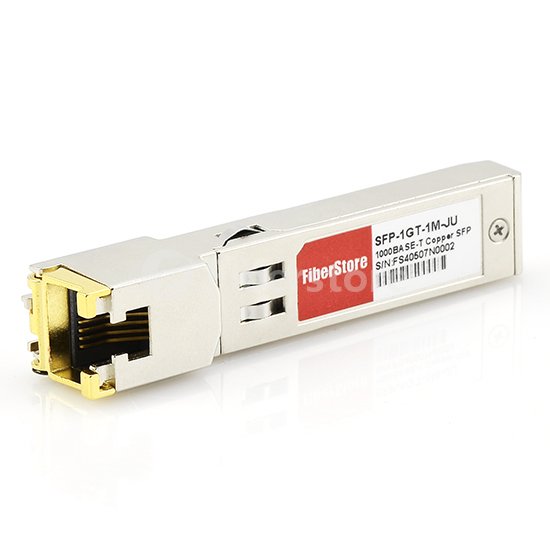
- Compliant with SFP Multi-Source Agreements standards (MSA)
- 10/100/1000 Mbps Auto-Negotiation
- Up to 1.25Gbps bidirectional data links
- Hot-pluggable SFP footprint
- Fully metallic enclosure for low EMI
- Low power dissipation
- Compact RJ-45 connector assembly
- Access to physical layer IC via 2-wire serial bus
- 10/100/1000 BASE-T operation in host systems with SGMII interface
- Link length up to 100m with four pair UTP cabling
10/100/1000BASE-T SFP modules are extremely versatile, working with many equipment that support the SFP type of interface: Ethernet switches, routers and any other networking equipment. They support 10/100/1000 Mbps data-rate in excess of 100 meters and are ideally suited for implementing small form-factor Network Interface Cards (NICs) and uplinks. As such, it is highly appropriate for use in such high-density applications as LAN 10/100/1000BASE-T Fiber Channel, Gigabit Ethernet LAN switch applications, Gigabit Ethernet media converters, switch-to-switch interfaces, switch to switch SerDes interface, switch to switch SGMII interface, switched backplanes, gaming devices, router/server interfaces and other optical transmission systems.
Fiberstore offers a wide variety of SFP modules (T, TX, SX, LX, ZX, CWDM, DWDM and BiDi) to meet your requirements, for example, Meraki MA-SFP-1GB-TX compatible 1000BASE-TX SFP copper transceiver, and HP JD089B compatible 1000BASE-T SFP copper transceiver. Our SFP modules have been tested and guaranteed 100% compatible with various Ethernet switches from major manufacturers like Cisco, HP, Nortel, Extreme, or Netgear. Fiberstore optics are thoroughly tested and are subject to an extensive qualification process before being considered certified to work in modules and switches.
Posted by: jowang at
08:18 AM
| No Comments
| Add Comment
Post contains 532 words, total size 6 kb.
March 08, 2016
SFP+, an enhanced version of SFP (small form-factor pluggable), can support data rates of 10 Gbit/s. 10G SFP+ transceiver is a popular industry format supported by many network component vendors. It plays an important role in today's network applications. There are different types of SFP+ modules, like 10GBASE-SR SFP+ module, 10GBASE-LR SFP+ module, 10GBASE-LRM SFP+ module, 10GBASE-ER SFP+ module, and 10GBASE-ZR SFP+ module. This article will introduce one of them, 10GBASE-LR SFP+ module.
10GBASE-LR SFP+ transceiver is designed for single-mode fiber and operates at a nominal wavelength of 1310nm. The 10GBASE-LR transmitter is implemented with a distributed feedback laser (DFB). DFB lasers are more expensive than VCSELs but their high power and longer wavelength allow efficient coupling into the small core of single-mode fiber over greater distances. Compared with 10GBASE-SR, the maximum range of 10GBASE-LR is 10 km.
10GBASE-LR SFP+ transceiver is a hot-swappable SFP+ module that plugs into SFP+ slots on switches. You can connect a 10GBASE-LR SFP+ transceiver while the system is powered on without causing any problems. This permits modules to be added or removed without interrupting the network. The SFP+ form factor is smaller than other form factors such as Xenpak, X2, and 10G XFP, ensuring lower costs, lower power disruption, and higher port density. It provides the necessary signal amplification for data to be transmitted to the network cable from the port, and vice versa, for the port to receive data from the network cable. 10GBASE-LR SFP+ transceiver supports 10G Ethernet, which results in very fast data transmissions of up to 10 Gbit/s. This is 10 times faster than Gigabit Ethernet and enables the switch to handle faster and higher data transmissions, making it very suitable for business needs.
SFP-10G-LR-S 10GBASE-LR SFP+: The Cisco SFP-10G-LR-S compatible 10GBASE-LR SFP+ transceiver, as shown in the following picture, supports a link length of 10 kilometers on standard single-mode fiber (SMF) (G.652). It is implemented with a DFB laser to support longer distances. And it uses a duplex LC connector.
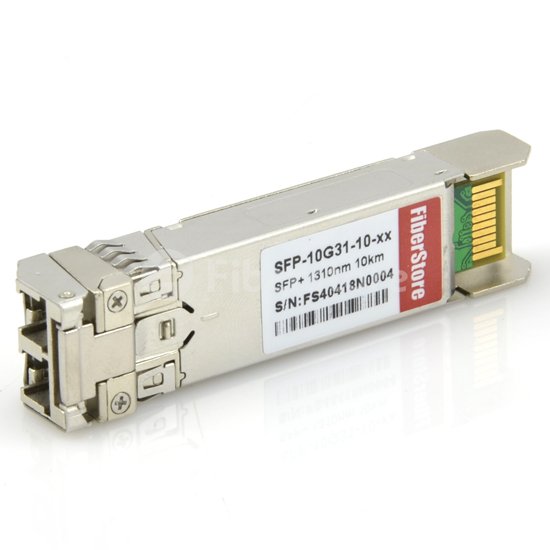
SFPP-10GE-LR 10GBASE-LR SFP+: The Juniper SFPP-10GE-LR compatible 10GBASE-LR SFP+ transceiver, as shown in the following picture, is guaranteed 100% compatible and functional in its intended equipments. This 1310nm DFB 10Gbps SFP+ transceiver is designed to transmit and receive optical data over single mode optical fiber for link length of 10km. Every SFPP-10GE-LR is environmentally tested in its specific port/platform prior to shipping to ensure that they are in perfect physical and working condition.
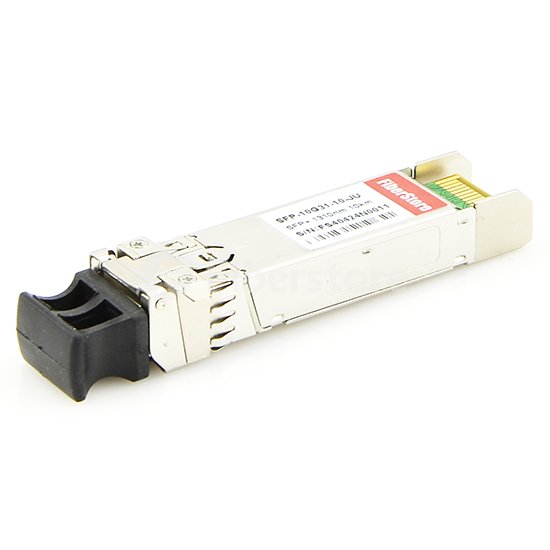
SFP+ transceiver is widely used to support communication standards including synchronous optical networking (SONET)/synchronous digital hierarchy (SDH), gigabit ethernet and fiber channel. Fiberstore manufactures a complete range of SFP+ transceivers. Fiberstore 10GBASE SFP+ module series transceivers offer a wide variety of 10G Ethernet connectivity options for data centres, enterprise wiring closets, and service provider transport applications. All of our 10GBASE-LR SFP+ transceivers are tested and fully compatible with major brands like Cisco, HP, Juniper, Brocade and Finisar. We offer high performance and low cost 10GBASE-LR SFP+ transceivers to fulfill customers' requirements.
Posted by: jowang at
04:13 AM
| No Comments
| Add Comment
Post contains 507 words, total size 6 kb.
March 03, 2016
SFP+ transceivers are popular hot-swappable input and output enhancement components that allow 10 gigabit connections. They are often used to connect a device motherboard to other equipment. To apply SFP+ transceivers to your applications, other than choosing a proper one, you also need to know how to instore and remove an SFP+ transceiver. This article will help you select, install, and remove SFP+ transceivers.
Before installing an SFP+ transceiver, first you have to select the appropriate transceiver to provide the required reach. How to select an appropriate SFP+ transceiver? There are two key points. One is to determine the required reach. Depending on the applications, you can obtain SFP+ transceivers for cable distances of up to 15m, 300m, 10km, and so on. The other is to determine wavelength restrictions or requirements. Different types of SFP+ transceivers are available to meet the wavelength requirements, like 10GBASE-SR SFP+, 10GBASE-LR SFP+, 10GBASE-LRM SFP+ and 10GBASE-ER SFP+. Usually, an SFP+ transceiver has a label on the top and bottom or side of it. The label will tell you some basic information about the transceiver and make it convenient for you to know whether you're installing the right one. For example, a picture of Finisar FTLX8571D3BCL compatible SFP+ transceiver is shown below. From the label, you can see that it is a 10GBASE-SR SFP+ transceiver.
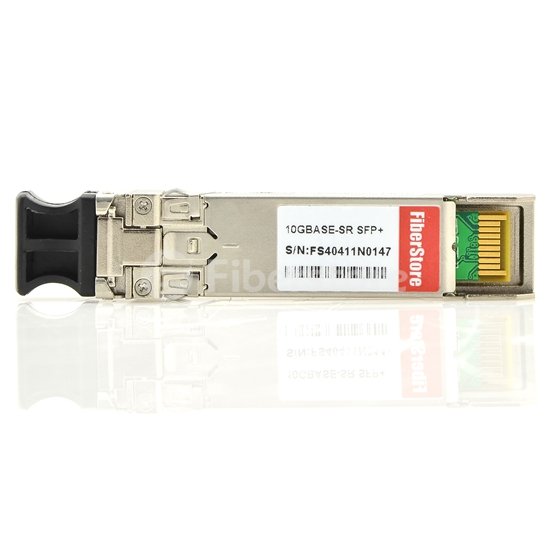
Procedures for installing an SFP+ transceiver:
- 1. Remove the SFP+ transceiver from its protective packaging.
- 2. Grasp the SFP+ transceiver between your thumb and forefinger.
- 3. Insert the SFP+ transceiver into an SFP+ slot on the switch, applying a light pressure to the SFP+ transceiver until the device clicks and locks into position. SFP+ transceivers are keyed to prevent incorrect insertion. If the SFP+ resists pressure, do not force it; turn it over, and reinsert it.
- 4. Remove the dust cover from the SFP+ optical bores and insert the fiber optic cable.
Remove an SFP+ transceiver to replace it or to commission it elsewhere:
- 1. Disconnect the network fiber optic cable from the SFP+ connector.
- 2. Affix dust covers over the fiber optic bore and connector.
- 3. Pull the swing-down latch handle and use it to extract the module.
- 4. Pull and slide the SFP+ transceiver out of the SFP+ slot. If the SFP+ does not slide out easily from the slot, use a gentle side-to-side rocking motion while firmly pulling the SFP+ from the slot.
- 5. Store the SFP+ transceiver in a safe place until needed.
During the process of installing and removing an SFP+ transceiver, there are several things that you need to keep in mind:
- 1.SFP+ transceivers are similar to SFP transceivers in physical appearance but SFP+ transceivers support 10 gigabit per second (Gb/s) connections. Do not install an SFP+ transceiver in an SFP slot. The two transceivers look the same but function differently. You must ensure that your switch supports SFP+ transceivers before installation or use.
- 2.SFP+ transceivers and XFP transceivers both support 10 Gb/s connections, but are not compatible devices. Do not install an SFP+ transceiver in an XFP slot. You must ensure the slot is an SFP+ slot before installation.
- 3.Verify that the SFP+ is the correct model for your network configuration.
- 4.Before you install the optical connector, ensure it is clean.
- 5.Risk of eye injury by laser. Fiber optic equipment can emit laser or infrared light that can injure your eyes. When installing or removing an SFP+ transceiver, never look into an optical fiber or connector port. Always assume that fiber optic cables connect to a light source.
- 6.To prevent damage from electrostatic discharge, always wear an antistatic wrist strap connected to an ESD jack.
Installation of an SFP+ transceiver needs careful operation. As for SFP+ transceiver choices, Fiberstore is a good choice. We offer a large range of 10G SFP+ transceivers. All our SFP+ transceivers are 100% compatible with major brands like Cisco, HP, Juniper, Brocade, Finisar, etc. For example, HP J9150A and Brocade 10G-SFPP-SR compatible 10GBASE-SR SFP+ transceivers, or Cisco SFP-10G-LR-S and HP 455886-B21 compatible 10GBASE-LR SFP+ transceivers, these are cost-effective modules and are fully compatible with major brand devices. We are dedicated to providing better products and service for our customers.
Posted by: jowang at
07:23 AM
| No Comments
| Add Comment
Post contains 709 words, total size 7 kb.
March 01, 2016
Passive SFP+ direct attach copper (DAC) cables, or SFP+ to SFP+ passive copper cables, are 10Gbps cables assembly. The cables are compliant with SFF-8431 specifications and provide connectivity between devices using SFP+ ports. And these cables use state-of-the-art signal processing technology to fill the expanding need for cost effective data center interconnects. Why would you choose passive SFP+ DAC cables? Information about passive SFP+ DAC cables will be offered in this article.
Passive SFP+ DAC cable assembly is fully compliant to the SFF-8431 SFP+ MSA. The cable construction is a 100 two pair shielded twinax with drain wires for digital ground. Passive SFP+ DAC cable allows for a serial data transmission up to 12Gbps in each direction. The passive design has no signal amplification in the cable assembly. Electronic Dispersion Compensation (EDC) is typically used on host board designs when passive copper cable assemblies are utilized. EDC allows for an extended length of passive cable assemblies. The mechanical design of the braid crimp and EMI skirt ensure that EMI radiation is sufficiently suppressed. Additionally, the copper cable acts as a natural heatsink. The low power consumption assists in making the passive copper cable assembly an economic solution for within rack or rack to rack applications. The following picture shows an HP J9281B compatible SFP+ to SFP+ passive copper cable.
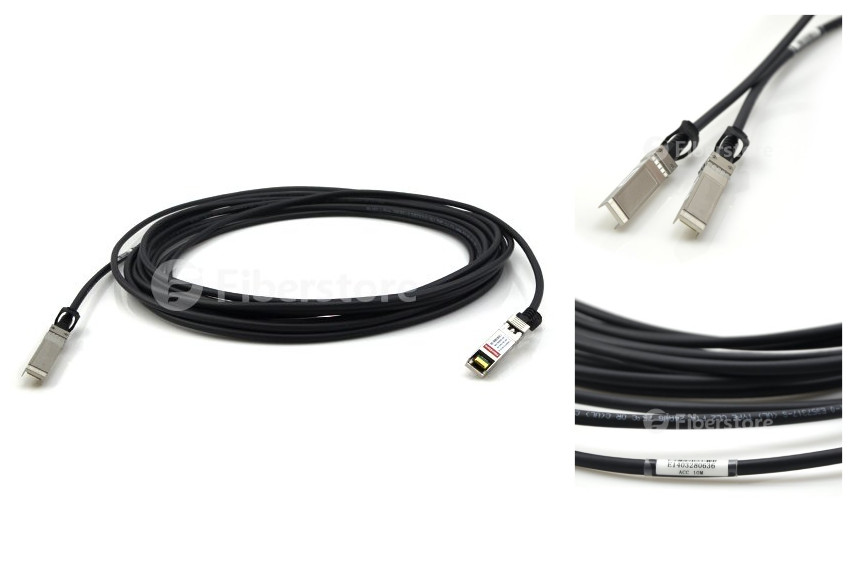
There are many solutions for 10G Ethernet applications. Why would you choose SFP+ to SFP+ passive copper cables? As the development of fiber technology, SFP+ to SFP+ passive copper cable still has its advantages in the market. Now, passive SFP+ DAC cables can support higher data rates than traditional copper interfaces. With the development of copper cable technology, passive SFP+ DAC cable is interchangeable and hot swappable with fiber optic modules. And most importantly, SFP+ to SFP+ passive copper cables are suitable for very short distances including 1m, 3m, 5m, 7m, 10m, etc. They offer a highly cost-effective way to connect within racks and across adjacent racks. SFP+ copper modules allow hardware manufactures to achieve high port density, configurability and utilization at a very low cast and reduced power budget.
The SFP+ to SFP+ passive copper cable assembly meets 10 Gigabit Ethernet, Fiber Channel and other industry standard requirements for performance and reliability. They support multiple protocols such as Gigabit & 10G Ethernet, 1, 2, 4, 8, and 10G FC, Fibre Channel over Ethernet (FCoE) serial data transmission, and Infiniband SDR, DDR, and QDR. SFP+ to SFP+ passive copper cables are high performance I/O solutions for 10G Ethernet and 10G Fiber Channel applications.
Passive SFP+ drect attach copper cable is a low cost, low power consumption and low latency solution that is ideal for high-density, in-rack 10Gb/s connections between servers and switches. Fiberstore manufactures and supplies a complete range of passive SFP+ drect attach copper cables for your applications. We provide compatible passive SFP+ DAC cables as alternatives to those branded companies like Cisco, HP, Juniper. For example, Cisco SFP-H10GB-CU1-5M compatible SFP+ to SFP+ passive copper cable, HP J9285B and HP JG081C compatible SFP+ to SFP+ passive copper cable, all these passive SFP+ drect attach copper cable are with high quality and fully compatible with their branded companies.
Posted by: jowang at
03:50 AM
| No Comments
| Add Comment
Post contains 547 words, total size 5 kb.
32 queries taking 0.0603 seconds, 90 records returned.
Powered by Minx 1.1.6c-pink.









